WHAT IS THE IMPACT OF DOCUMENTARY VERSUS TABLEAUX PHOTOGRAPHY IN TELLING A STORY?
‘To photograph is to appropriate the thing photographed.’ (Sontag S. 1977)
The meaning of this quote is to explain the difference between the real thing itself and an image of the real thing. The photograph of the real thing is only an appropriation, or rather a representation of that thing which the camera recorded, or the photographer chose to frame in a picture. However, the photograph itself as a print, is a real object that exists in the world.
Introduction
This essay explores two aspects of photography; documentary and tableaux, in their unique ability to entice and seduce the viewer to comprehend the story that is being told. Both photographic methods attempt to convey a story in a historical timeframe; documentary photography is often used in reportage (Tate.org) by comparison a photograph that uses tableaux can feel pre-planned and hence staged. Although, the two approaches maintain a common purpose in communicating a narrative, the method behind how each photograph has been produced is completely different.
The origin of tableaux photography emerges from Pictorialism in the late 19th century. The word documentary was first coined by British filmmaker John Grierson in 1930s. The line between a tableaux photograph being staged and posed and a documentary photograph showing ‘reality’ isn’t as black and white as the definitions say. For example, some photographers such as Tyler Mitchell and Justine Kurland fuse together both the real with the imaginary. (Gelder 2010). This means that to keep this essay on track, I will be explicitly focusing on obvious documentary or tableaux style photography.
This essay primarily analyses one historical and two contemporary image-makers; Dorethea Lange’s Migrant Mother, Paul M Smith’s tableaux photography focusing on masculinity and recreating scenes of war, and Neil Leifer’s documentary photos of sports. These artists were previously explored as part of my personal study, including them in this essay permits me to take a deeper dive into their images and make comparisons between tableaux and documentary styles.
Storytelling in photography is of particular personal interest, because my previous studies explored creating visual narratives of St Malo and St Helier Harbour, producing two different outcomes, magazine double spread and a photo-zine. My approach taken in both cases were documentary based. A similar approach will be taken to my current project, however this time the subject being explored will be basketball and the commitment and determination that a sports person needs.
Documentary – Contemporary Example
Documentary photography is the recording of people, events and places to create an accurate record or story. Documentaries are traditionally supposed to show ‘reality’ as well as highlighting issues and for promoting change (Tate.org). However, it can also be used as an art form. It is similar to, though not the same as reportage photography.
In its infancy photography was originally used for scientific purposes. This meant that a camera was only used for documentary purposes; nothing more than a simple record of reality. “This is one of the founding arguments about photography right from the moment of its original invention, that is, its capacity to store and reproduce other objects as a visual image” (Bate 2010).
Photographs only started moving towards a true art form in the late 19th century, gaining a similar artistic status to paintings and sculptures. This is known as the pictorialism movement, starting in the late 19th century and continued growing after. This meant photography can be a ‘naked’ and unaltered image that shows truth, or an artistic image, that the photographer planned to make it unique and impossible to replicate. This is where photographs start drifting away from a true depiction of history and to a depiction of the thoughts that a photographer has. The idea of a ‘Naked Image’ when referring to documentary photography is used represent history to fact and reality, as its often accepted to not tolerate any other form of presentation when it comes to a documentary photo. However, it’s impossible to take a photograph without aesthetics being added. And often, the most basic and obvious examples of a ‘document’ in a photograph end up being a formation of art photography.
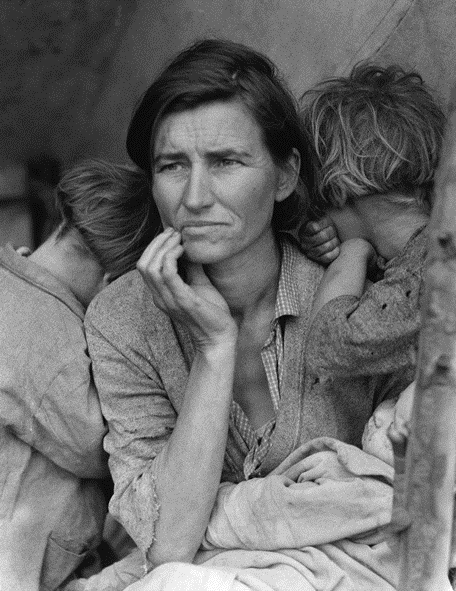
Above Dorothea Lange ‘Migrant Mother’ – example of documentary photograph taken during the Great Depression in USA during the 1930s.
The composition draws your eye to her face, which is tired and shows she is worn out, and hopeless. The image was used to raise awareness to the many Americans, especially farmers, that faced this kind of poverty (Eschner 2017). According to Lange, she approached the woman – as if drawn by a magnet – and snapped five pictures. Lange didn’t ask her name, but did hear of how the woman had sold the tires of her car just to buy food. Years after the photograph was published the subject of the photograph came forward to given her account. She said that she had not been paid and was told that the photograph would not be published. There are another five photographs of the same scene taken by Lange. In each photograph the furniture and the children are in different locations (Davis 2020). This has led to accusations that the final, iconic, picture was posed, staged. If this was the case does this take away the value of the image? As Bate (2010) said “in terms of history and memory, photographs demand analysis rather than hypnotic reverie” (Bate 2010).
Documentary – Neil Leifer
A more recent photographer, and someone who is an inspiration for my own personal studies, is Neil Leifer. Leifer has been documenting key sporting events in America for 60 years and is responsible for many classic sporting images (nielleifer.com). His style is primarily documentary and portraiture. He has taken many posed photographs of famous sports personalities however it is his documentary photographs that this essay will focus on.
Neil Leifer puts his success down to luck and being in the right place at the right time, however he also emphases the need to recognise that a great shot is there and grab it, even when it may be fleeting: “what separates the top photographers from the run-of-the-mill photographers is that when you get lucky a good photographer doesn’t miss.” (NPR 2016).
One of Leifer’s successes has been getting the camera in the right spot. He says this takes time and planning. For his famous shot of Ali v Williams boxing match at the Houston Astrodome in November 1966 he arrived four days before the match to set up and test his remote camera mounted in the rafters. He then took the film to the developers and waited for it to be processed “most photographers don’t hang around the magazine’s photo labs, but I would go to make sure they didn’t mess up my film” (Jonze, 2020). So, for sports documentary, it is important to be think ahead and plan and to control what you can, however it is equally important to be constantly on the lookout for ‘the shot’ and ensure you do not miss it.
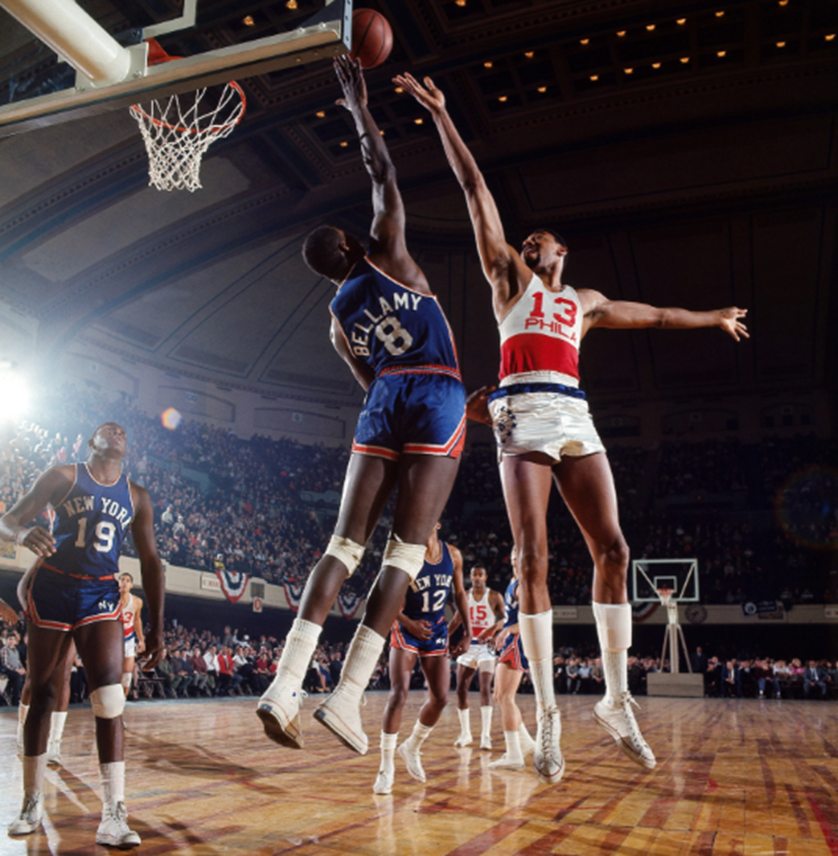
Above Philadelphia 76ers center Wilt Chamberlain shoots over Walt Bellamy of the New York Knicks during a game at Convention Hall. Philadelphia, Pennsylvania. March 1966 (neilleifer.com)
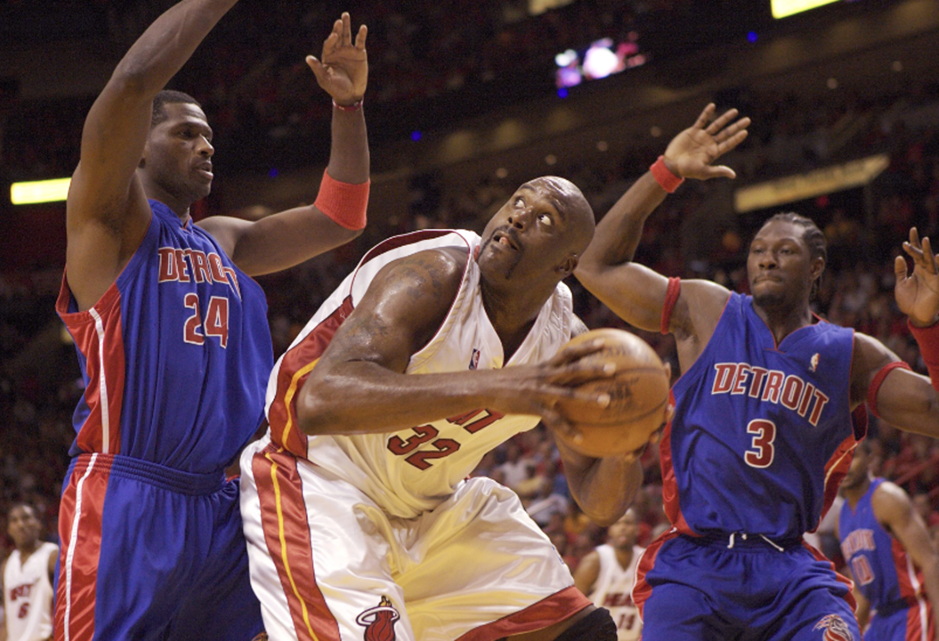
Above Miami Heat center Shaquille O’Neal goes up against Antonio McDyess and Ben Wallace of the Detroit Pistons during Game 5 of the 2005 NBA Eastern Conference Finals at American Airlines Arena. Miami, Florida. June 2, 2005. (neilleifer.com)
Above are some of my favourite basketball photographs taken by Leifer many years apart. With the first image, you can see a bright light shining on the players from the left, casting long and ominous shadows. Both players reaching for the ball are fully in the frame, making these players seem even larger than they are, this and the dynamism of the players is exaggerated by the wide angle lens and by having the camera low to the ground. This image is a good documentation of what basketball looked like back in the sixties, especially when compared to the second image with Shaquille O’Neal forty years later. You can see how the clothing has changed to being baggier, as well as the players being larger on average. The photograph captures the split-second pause as O’Neil eyes onto the basket before he shoots. O’Niel, in white, is framed on both sides by McDyess and Wallace, in blue. McDyess’s and Wallace’s eyes are both on O’Neil, drawing the viewer to the central figure. O’Neil’s eye’s are focused hard on the basket, which being out of shot sends the viewers gaze off to the top left of the image. This is a perfect example of what Leifer means when he says that good photographers do not miss the shot.
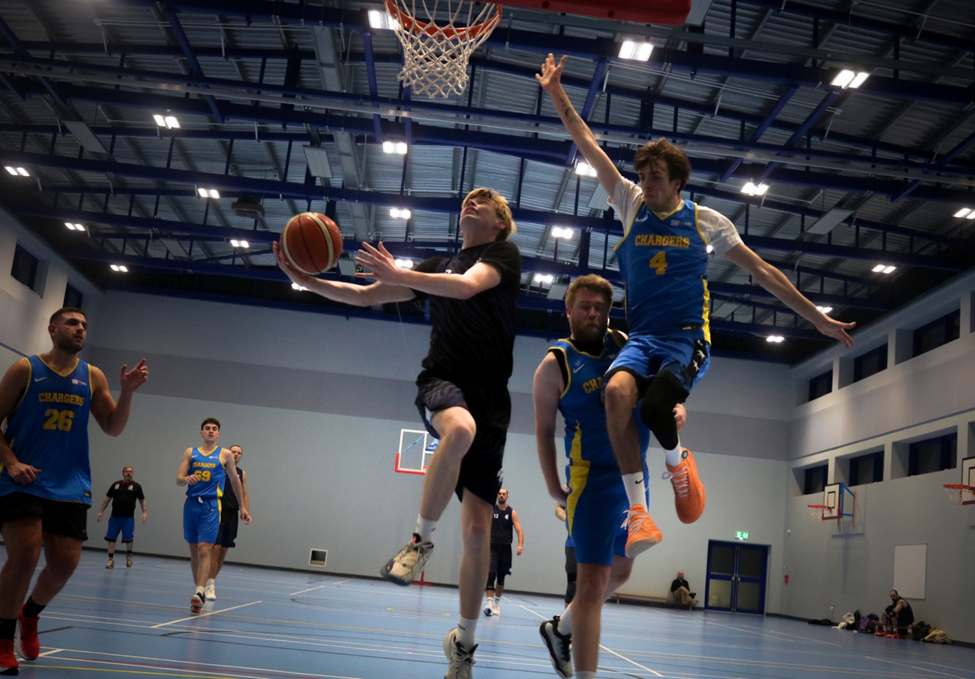
Above is one example from my photoshoot that I took during a D1 game in Jersey. I tried to replicate Neil Leifer’s Images by sitting close to the basketball hoop as well as using a wide-angle Lense to capture a wider field of view.
Tableaux
Tableaux photography is staged and often posed. The people in the photographs may be wearing costumes and props may be used along with artificial lighting to create a scene. Tableaux photography is an evolution from art, for example Renaissance paintings depicting scenes from the bible or mythology. People in tableaux photographs are staged such that they appear to be absorbed in their actions or surroundings and unaware of the photographer. (Tate and Pilgrim 2023). Tableaux photography operates in the space between reality and fiction, drawing the viewer into a scene that feels both familiar and uncanny. (David Bate). This tension between reality and fiction allows tableaux photography to be so powerful when it comes to telling a story.
Below is a modern (amateur) example of a tableaux photograph below The Last Supper by Renaissance artist Leonardo da Vinci. The image, clearly posed by medical staff trying to have some light relief during the Covid Pandemic, is an example of a classic tableaux photograph, depicting a scene from the bible. (Smith 2020).
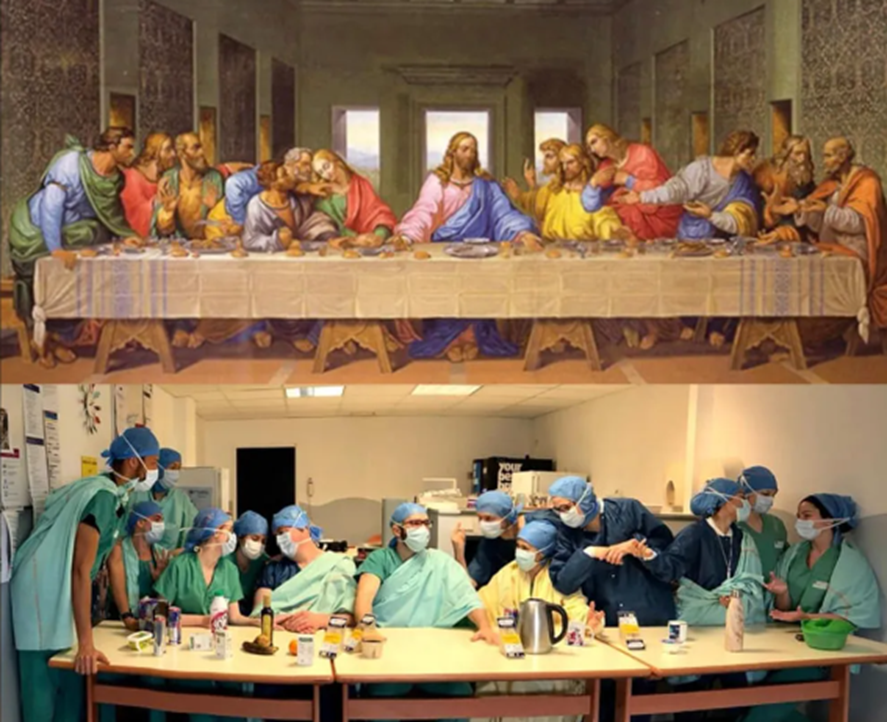
Above – The Last Supper painting by Leonardo da Vinci and tableaux by doctors at a hospital in Paris during the Covid pandemic (Smith 2020).
I’ve already talked a little bit about pictorialism in this essay, however, almost all tableaux photographs contain ideas from pictorialism and adds an aesthetic that’s pleasing to the viewer. Many contemporary photographers didn’t agree with this new movement at the time saying it marks a shift from an emphasis on ‘truthful’ representation to a recognition of its constructed nature. However, photographers that followed pictorialism believed it allowed viewers to pause and analyse them, allowing them to find there own meaning and symbolism. This can increase a story’s impact on the viewer as they are able to relate the photo to other moments in their own life, instead of taking the photo at face value which is often the case for documentary photography.
Tableaux – Paul M Smith
At first sight the images of Paul M Smith would not appear to be part of the tableaux genre. Smith is a British photographer who has produced several sets of images on the theme of masculinity. While his photographs appear to have the theme of documentary they are actually posed, and a large amount of effort has gone into capturing and editing the images in which, he, is often the only person in the photographs. These photographs do not record real events and are completely staged, they are tableaux.
In ‘Artist Rifles’ Paul M Smith takes self portraits of himself dressed as different soldiers and uses photomontage to create fictional military scenes (some of which are relatively graphic, such as execution and burials).
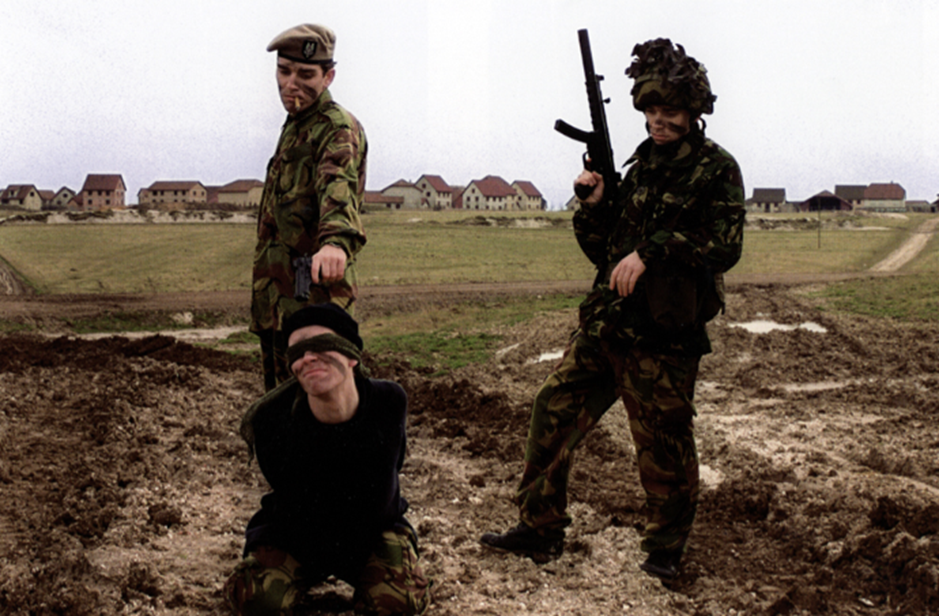
Above Paul M Smith photograph taken as part of his Artist Rifles series. In this photograph each of the soldiers is posed by Paul M Smith himself and the image put together as a photomontage. While having the appearance of a documentary image, it is entirely posed and fictional.
This image and the rest of the ‘Artist Rifle’ series contradicts the ideal view of courageous and well-known superheroes against that of a soldier, since he previously produced a series called ‘Action’ which mocks the masculine ideas of a superhero. Solders are unfortunately often seen as faces among the masses. This makes them heroes, not through their individuality or charisma, and instead by the difficulties of being a soldier. The use of tableaux allows Smith to recreate images with a high level of emotion, as he can control every aspect of the image, including the subjects himself since he is the subjects. When he took these photos back in the 1990s, it was much harder to replicate himself without the current technology, making these images more visually striking to the viewer. The multiple self-portraits also emphasise the idea of ‘brothers in arms’ in war, where they all work as one unit. This image above is particularly realistic as well, not just with the subjects’ actions, clothing and placement, but the baren and war-like background, allowing a strong effect on the viewer. The cigarette in the left soldier’s mouth and the rifle in the right soldier’s arms is almost over exaggerating the stereotypes of masculinity since the viewer knows its staged, giving an amusing effect allowing the viewer to participate in the fantasy. Looking past the depiction of masculinity, the details in this image that Smith planned makes it seem like a real event.
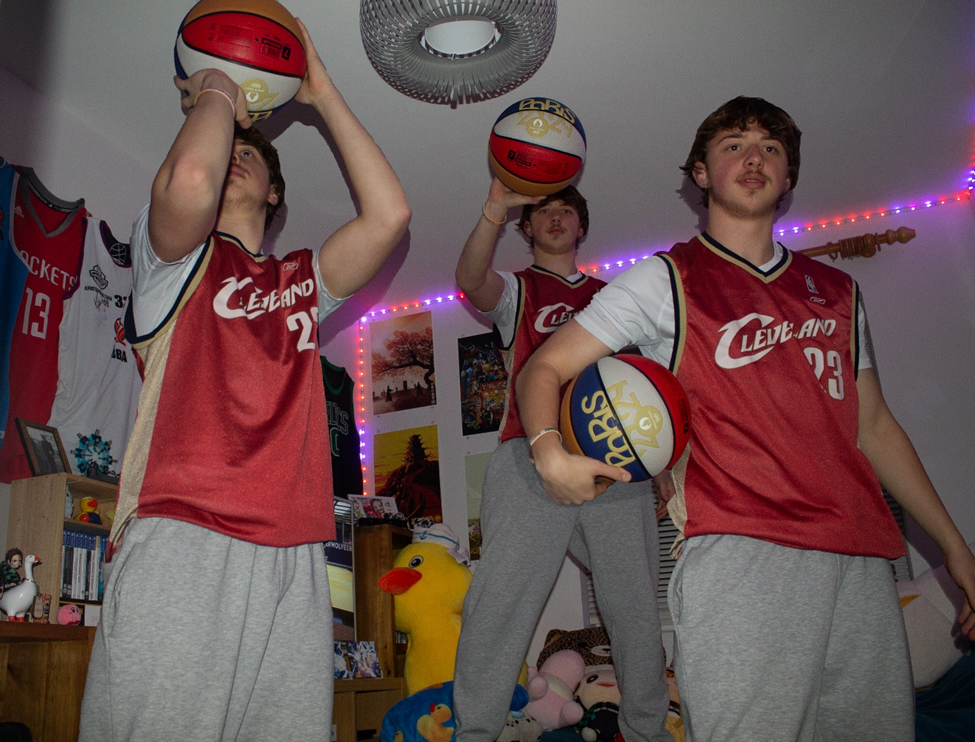
Above is my attempt at replicating photomontage in the style of Paul M Smith. I used photoshop to replicate the subject multiple times performing different things that are ‘basketball’ related.
Conclusion
It is clear from the examples given that both documentary and tableaux have the ability to tell a story.
Lange has potentially manipulated her image by having the mother and her children pose for the final and most famous image. Does this detract from Lange’s purpose of documenting the impact of the Great Depression and spreading the news of the suffering to the rest of America and the world? Does it remove the title ‘documentary’ from the image? Is it ‘fake? The truth is that the mother in the photograph was homeless and the children were starving. Perhaps all Lange is guilty of is using her skill as a photographer to marginally manipulate the story to make a greater impact on the reader, and by doing so raise the plight of the mother and others in her difficult situation?
It is interesting to compare the images of Lange with the sports photographs of Leifer. Both are well known documentary photographers, working at different times with very different subjects. However while the documentary images of Lange have a shadow of doubt over their ‘authenticity’ it is clear that the images taken during sports events by Leifer are true representations of what actually happened, the story of the match. It is very unlikely that these would be staged in anyway, and instead they are the product of a photographer who has the ability to foresee and capture a great image in the instant it happens during a fast-paced sports event.
The purpose of tableaux photography is to tell a story, whether that be the bible story of the last supper, the trials of working in a hospital during the Covid Pandemic, or the modern representation of masculinity and warfare.
Smith’s photographs are deliberately fabricated to mimic documentary wartime photographs. Only by looking closely is it apparent that all the people are posed by Smith himself. This creates a contrast between documentary photos and tableaux photos. Does a documentary photo carry more emotion because there are no lies? Or a tableaux photo, which can be endlessly modified to maximise the emotion the photographer is trying to create? It is my view that impact is not from whether the photograph fits the ‘tableaux’ or ‘documentary’ genre. Rather it more the ability of the photographer to convey the message they wish to tell. A documentary photographer who asks (implicitly or explicitly) the subject to change their pose, position etc, and in doing so is able to make a more powerful image while the most important elements of the truth remain is equally valid as the obviously posed tableaux that examines the meaning of its subject.
Bibliography
Bate, D. (2010) ‘The Memory of Photography’, photographies, 3(2), pp. 243–257. doi: 10.1080/17540763.2010.499609.
Davis L. J. (2020) ‘Migrant Mother: Dorothea Lange and the Truth of Photography’ https://lareviewofbooks.org/article/migrant-mother-dorothea-lange-truth-photography/
David_Bate ‘The Art Of The Document’
David_Bate ‘The_Pictorial_Turn’
Gelder, H. V. (2008), ‘Photography Today: Between Tableau and Document’, Photographie Volume 28, numéro 1-2, URL : https://id.erudit.org/iderudit/044589ar
Pilgrim, F. (2023) ‘Dreaming in Real Time’: How staged tableaux disrupt notions of authenticity in documentary photography’ https://www.felixpilgrim.com/blog-1/staged-tableaux-and-documentary-photography
Eschner (K), (2017) ‘Meet 10 Depression-Era Photographers Who Captured the Struggle of Rural America’, Smithsonian Magazine. https://www.smithsonianmag.com/smart-news/meet-photographers-charged-documenting-depression-era-america-farm-security-administration-180964123/
Smith W. S. (2020) ‘Tableaux Vivants Are Giving Us Life During the Pandemic’ Art News https://www.artnews.com/art-in-america/columns/ableaux-vivants-replicate-art-masterpieces-during-covid-19-quarantine-1202686492/
Jonze, T. (2020) ‘Muhammad Ali flattens Cleveland Williams: Neil Leifer’s best photograph’ The Guardian. https://www.theguardian.com/artanddesign/2020/dec/02/muhammad-ali-cleveland-williams-neil-leifers-best-photograph
NPR (2016), ‘A ‘Relentless’ Sports Photographer Explains How He Got His Shots’ NPR. https://www.npr.org/2016/05/06/476893044/a-relentless-sports-photographer-explains-how-he-got-his-shots
Sontag S. (1977) ‘On Photography’ Farrar, Straus and Giroux

Joey
I like the fact that you are trying to challenge certain aspects of each genre, and you are asking some probing questions in the conclusion too.
However, there is a bit too much going on throughout the essay and it seems to go in different directions to often. There is no clear image analysis and interpretation either—which is vital really.
Have you employed Mirrors and Windows here ? If not, why not ?!
Your title / question requires attention (the word impact does not fit here )